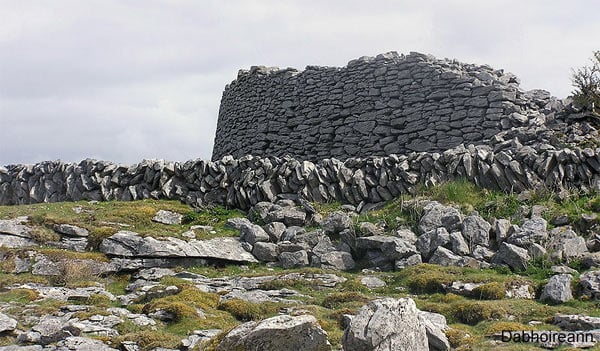Burials uncovered in Ireland reflect fusion of Paganism and Christianity
Excavations at Caherconnell in County Clare, Ireland, have uncovered ancient burials that reflect a fusion of Pagan practices with Christianity. Although it was initially believed that Christianity was well established in Ireland by the 5 th Century, the latest finding reveals that Celtic Paganism was not quick to die out.
The discovery was made by the Caherconnell Archaeology Field School who found a casher, otherwise known as a caher, which is a circular dry-stone enclosure containing dwelling houses and other domestic structures. It had been deliberately constructed over the top of an earlier burial mound containing two limestone boxes, known as cists, holding the remains of a woman and two babies. The results of radiocarbon dating have revealed that the human remains date from the second half of the 6 th century AD to the first half of the 7 th century AD. This places them well within the chronological bounds of what was once termed ‘Early Christian Ireland’.
The circumstances of the burial reflect both Pagan and Christian influences. Following the Christian tradition, the bodies were unaccompanied by grave goods such as clothes, jewellery, and weapons, which were typical of pagan burials, and they were laid out almost east-west, in keeping with Christian practices. They were not, however, interred in a Christian cemetery. Instead, they were placed in slab-built cists beneath a low stony mound. Such cists and mounds are commonly found in the pre-Christian prehistoric past. According to Michelle Comber, Director of the Caherconnell Archaeology Field School, these people appear to have combined their traditional belief system with elements of the ‘new’ religion.
Three to four centuries later, the high status cashel settlement called Caherconnell was built at this location. The builders of this new home did not clear this mound and its contents out of their way or try to avoid the mound. Instead, they built the drystone wall of their enclosure directly over the top of the mound. Michelle Comber believes it is likely that knowledge of the mound and what it contained survived into the 10th/11th century AD, and that the new occupants of the ste deliberately incorporated these ancestors into their settlement. Like the earlier burials themselves, this practice also has pre-Christian associations.
As Christianity became the official religion in Ireland, religious practices generally began to reflect this change. The establishment of Christianity as the official religion brought the need to organize and regulate its doctrine into a coherent monotheistic philosophy that contrasted quite drastically with the pagan practices of the time. The multiple gods, rites, and celebrations came to be considered unfounded from an intellectual point of view, criticized as superstitious, and open to constant re-interpretation. But Christian leaders were clever enough to realise that people would not abandon their beliefs easily, so the practice of assimilation was implemented in which most pagan religious practices were transformed in order to teach the Christian message in a way that was culturally relevant and easy to understand.
Nevertheless, it seems that in the case of Caherconnell, pre-Christian traditions were not easily abolished and persisted well into the 10 th century. It is highly unusual to find a settlement of a noble family from medieval times choosing to live as their ancestors had before them. “This may have been a deliberate choice, proclaiming their ancestry in a changing world where intrusive groups from outside (initially the Anglo-Normans, later their English descendants) were threatening the native way of life,” wrote Ms Comber.


















Comments
Great article!
It fascinates me how different religions/cultures/practises morph together - there rarely seem to be sharp boundaries.
One of my favourite sites in Yorkshire is Rudston Monolith near Bridlington - described as the largest megalith in England, it towers over the Church that has been built next to it! It was one of my first 'introductions' to the idea that 'many things have come before!'
Sculptures, carvings & artwork inspired by a love of history & nature: www.justbod.co.uk
It is also my opinion that not everyone is a war like as history makes us out to be. I believe we have and can live in harmony, no matter what our differences of opinions are. Since Constantine, Christianity has blended other religous beliefs into their own. For example, the erronous birthday of Jesus, Early Christians were naked when they were baptized. After immersion, they then put on white clothing and a crown. They carried a candle and walked in a procession to a basilica. Followers of Mithra were also baptized naked, put on white clothing and a crown, and walked in a procession to the temple. However, they carried torches. Antoher example, The Bible records that Jesus was crucified between two thieves. One went to heaven and the other to hell. In the Mithras mysteries, a common image showed Mithras flanked by two torchbearers, one on either side. One held a torch pointed upwards, the other downwards. This symbolized ascent to heaven or descent to hell. The list goes on and on. Christianity is like America, an amlgamation of different beliefs and ideas from different cultures and religions all blended together to fit the needs and beliefs of the time and the people therein.
It seems as though this is nothing new, at least to me it seems like these two religions or belief systems have been batteling (in a manner of speaking) for a long time, Christianity trying to eliminate the pagans and convert the to Christianity. Europe was pagan for a long long time, before Christiantiy crept in and took hold in the area. Most of the Christian movement started in the Britttish Kingdom and spread from their power and influence.
My studies have indicated that before Irish Christians were forced into the Latin mold, Celtic Paganism was not deliberately obliterated, but rather "baptised." Thanks for this article.
Sr. Patti E. McClellan.OMC
St. Ciaran's House of Prayer